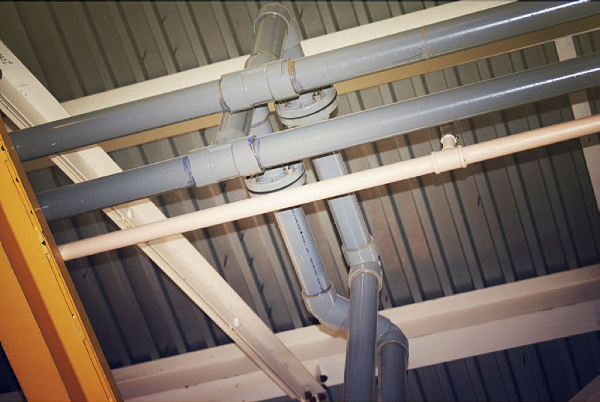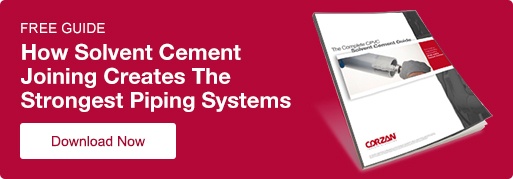Why Solvent Cement Handles Stress Better Than Threaded Joints
Industrial applications are demanding environments for any piping system, placing stress on materials and joints. Piping materials and their connections must be able to withstand challenges such as constant vibration and water hammer, extreme temperatures, changing pressures and exposure to highly corrosive chemicals.
Thermoplastics such as CPVC represent a high performance option for most industrial piping installations and are generally joined with solvent cement as a fast, easy and highly reliable process resulting in joints that are stronger than either the pipe or fitting alone. Threading is another joining alternative along with flanged or mechanically joined piping – depending on the diameter of the system and the severity of the service.
The ultimate test for any pipe joining method is whether it will hold together and facilitate materials movement over the long term. The piping product and joining method must be able to keep the facility operating efficiently while protecting workers from exposure to potentially hazardous substances.
Solvent Cement Joints vs. Threaded Joints
Issues that develop with piping systems often involve the connections, which are typically the weakest part of the system and the most likely to fail. Solvent cement is used for permanent lines with conventional fittings and chemically fuses the pipe to the fitting for a highly reliable joint that can withstand harsh chemicals, high temperatures, pressure and impact.
The video footage that follows demonstrates the strength of a Corzan® CPVC solvent cement welded joint during a burst test conducted according to ASTM D1599 requirements. The solvent cement welded joint performs under intense internal pressure, with ASTM F441 requiring a one-inch schedule 80 CPVC pipe to withstand 2020 psi before failing. The Corzan CPVC pipe did not fail at 2900 psi, the burst unit’s limit.
It should be noted that while utilizing solvent cement joints is a simple process, it is still a process. Understanding proper solvent cement selection, the applicator, and method is critical in obtaining results as shown in the video. Anyone wishing to form high quality joints should use bonders that have been qualified to the ASME B31.3 bonder qualifications.
Threading has also long been used as an acceptable method to transition piping systems or connectivity with flow, temperature, or pressure indicators. Threading is commonly employed with low pressure piping transporting low risk fluids. In plastics, owners should always be aware that there are two types of threads utilized in the field. Non-metallics frequently employ solvent cement fittings that have molded threads. Those familiar with metals are very familiar with the threading of the actual pipe. Threading of pipe for joints should be used for heavier wall thicknesses; Lubrizol Advanced Materials recommends threading be utilized only with Corzan CPVC Schedule 80 piping for sizes up to and including a 4-inch diameter operating at 130°F (54.4°C) or less. Threads must be in accordance with ANSI B1.20.1 Taper Pipe Thread.
Threaded CPVC pipe, however, is rated at 50 percent of the pressure rating of Schedule 80 pipe at the operating temperature. Schedule 80 pipe larger than four inches or piping systems that will operate at temperatures exceeding 130°F should be solvent cemented, flanged or mechanically coupled rather than threaded. Thinner wall schedule 40 pipe should never be threaded.
While threading CPVC is often considered a less expensive alternative for creating connections, plastic threads are similar to stainless steel threads in that they may be perceived as soft. It is important to avoid overtightening threaded plastic joints, which will weaken the joint.
ASTM plastic pipe standards are helpful when specifying, testing and evaluating the design and installation requirements for plastic tubing and fittings. ASTM F441, F439, F438 and F1970 standards ensure pipe materials and fittings are engineered and manufactured to exact standards with tolerance on pipe interior diameter (ID), outside diameter (OD) and wall to confirm the materials will properly fit together when joined.
All piping materials and fittings must be compatible with the chemicals and other materials they will carry. The Corzan Chemical Resistance Chart compares the compatibility of Corzan CPVC against more than 400 chemicals.
Understanding the Solvent Cement Joining Process
Solvent cement includes CPVC resin, stabilizers and fillers in a variety of solvents. The solvents dissolve the CPVC resin and prepare the surface of the pipe and fittings by softening the top layers of the material, which loosens the molecular structure. The taper in the fitting socket creates an interference fit that ensures contact between the pipe and fitting that allows the material to fuse to itself when the two pieces connect.
Solvent cement must be allowed to cure while the molecules harden and the solvent flashes off. The joint is fully cured only when the solvent completely evaporates. Solvent cement set and cure times will depend on the pipe size, temperature, relative humidity and the tightness of the fit.
Piping systems with features such as expansion loops should also be joined with solvent cement, which will allow the pipe to bend and move without breaking or weakening the joint seal. CPVC solvent cement should always be used with CPVC pipe and fittings, although different applications and pipe sizes will require different solvent cement viscosities.
Determining the Most Appropriate CPVC Pipe Connections
Threading has long been used as an acceptable method to transition low pressure piping systems that transport low risk fluids. Solvent cement, however, is generally the preferred method for connecting thermoplastics such as CPVC as it provides a joint that is stronger than either the piping material or fitting alone and can withstand the stresses common to challenging industrial environments.
Corzan Industrial piping systems offers a 60-year history of success providing products for a wide range of industrial applications worldwide. Contact a Corzan engineering expert or one of our partner manufacturers for engineering guidelines to make safe and reliable system transitions or to schedule a free process suitability review and technical assessment.
Details for this blog were taken, in part, from the following:
https://www.corzan.com/blog/cpvc-pipe-joining-methods-impact-efficiency-productivity
https://www.corzan.com/blog/the-dos-and-donts-of-cpvc-piping-solvent-cement-welding
https://www.corzan.com/en-us/piping-systems/installation/threading


